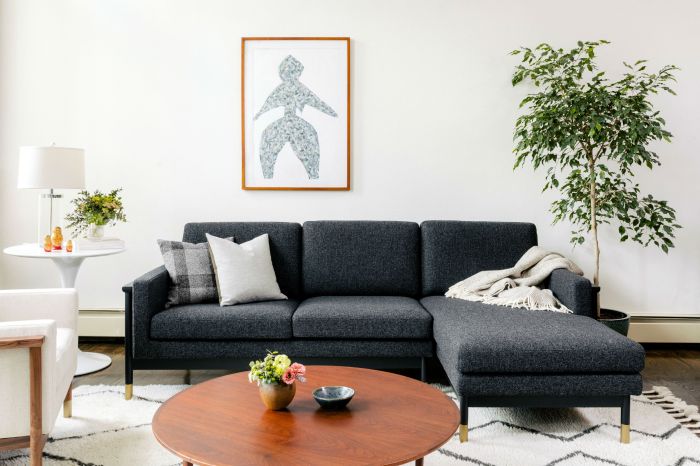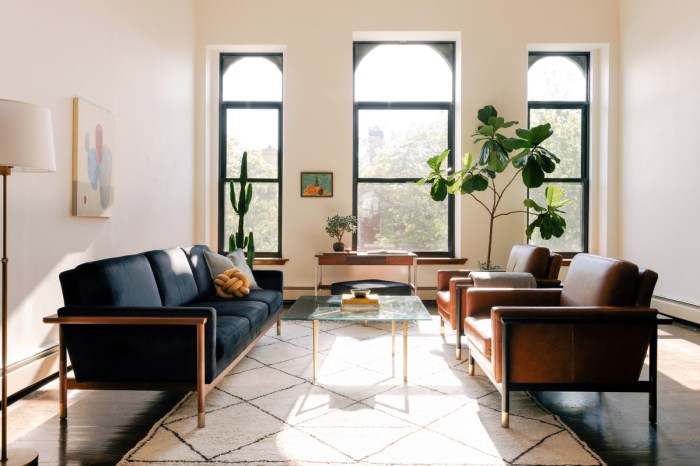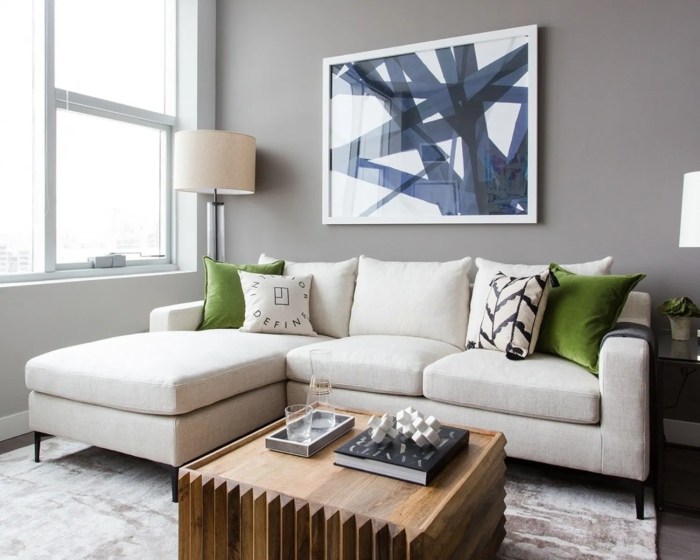Embark on a journey into the realm of interior define furniture, where aesthetics and functionality harmoniously intertwine. From the cozy confines of living rooms to the sleek elegance of modern offices, interior furniture plays a pivotal role in shaping our living and working spaces.
In this comprehensive guide, we delve into the diverse world of interior furniture, exploring its types, styles, materials, and the latest trends that are reshaping the industry. Discover how to select furniture that not only complements your personal style but also enhances your comfort, productivity, and overall well-being.
Define Interior Furniture
Interior furniture refers to the movable items placed within a building to support various activities and enhance the functionality and aesthetics of the space. These furnishings play a crucial role in creating a comfortable, inviting, and functional living environment.
Interior furniture encompasses a wide range of items found in different rooms of a house or commercial building. Common examples include:
- Living Room:Sofas, armchairs, coffee tables, entertainment units
- Bedroom:Beds, dressers, nightstands, wardrobes
- Dining Room:Dining tables, chairs, sideboards
- Kitchen:Cabinets, countertops, appliances
- Bathroom:Vanities, mirrors, bathtubs, showers
Types of Interior Furniture
Interior furniture encompasses a diverse range of furnishings that serve various functional and aesthetic purposes within a space. From seating and storage solutions to lighting and decorative elements, each type of furniture contributes to the overall ambiance and functionality of a room.
To provide a comprehensive overview, we have categorized interior furniture into four distinct types based on their primary function:
Seating
Seating furniture is designed to provide comfortable and supportive surfaces for sitting. This category includes a wide range of options, from sofas and chairs to ottomans and stools. Each type of seating furniture offers unique characteristics and can be tailored to suit different styles and needs.
Interior Define’s modern furniture is renowned for its sleek lines and timeless appeal. For a wider selection of styles, consider exploring haverty furniture . While they offer a more traditional aesthetic, their pieces can complement Interior Define’s contemporary designs, creating a harmonious and inviting space.
- Sofas:Multi-seater upholstered furniture with cushions, ideal for lounging and socializing.
- Chairs:Single-seater upholstered or non-upholstered furniture with backrests, designed for various purposes.
- Ottomans:Upholstered footrests or small seating units that can serve as extra seating or storage.
- Stools:Non-upholstered seating without backrests, typically used for dining or as accents.
Storage
Storage furniture provides solutions for organizing and concealing belongings, contributing to a tidy and clutter-free space. This category encompasses a wide range of options, from cabinets and dressers to shelves and baskets.
- Cabinets:Enclosed storage units with doors or drawers, ideal for storing bulky items or sensitive belongings.
- Dressers:Chest-of-drawers with multiple drawers, designed primarily for storing clothing.
- Shelves:Open or closed storage units with horizontal surfaces, suitable for displaying books, décor, or other items.
- Baskets:Woven or fabric containers with handles, used for storing small items or adding a touch of texture to a space.
Lighting, Interior define furniture
Lighting furniture plays a crucial role in illuminating a space and creating the desired ambiance. This category includes various types of fixtures, from chandeliers and pendants to table lamps and floor lamps.
- Chandeliers:Suspended light fixtures with multiple arms and bulbs, often used as a central focal point.
- Pendants:Single-bulb light fixtures suspended from the ceiling, providing focused illumination.
- Table lamps:Portable light fixtures placed on tables or desks, offering localized lighting.
- Floor lamps:Tall, standing light fixtures with adjustable shades, providing ambient or task lighting.
Décor
Décor furniture encompasses a wide range of items that add visual interest and personal style to a space. This category includes everything from artwork and mirrors to rugs and throw pillows.
- Artwork:Paintings, sculptures, or other artistic creations that enhance the aesthetic appeal of a space.
- Mirrors:Reflective surfaces that can create the illusion of space, add light, and reflect décor.
- Rugs:Floor coverings that define areas, add warmth, and enhance the overall ambiance.
- Throw pillows:Decorative cushions that add comfort, texture, and a touch of color to seating furniture.
Styles of Interior Furniture

Interior furniture comes in a wide range of styles, each with its unique characteristics and appeal. The style of furniture you choose for your home can significantly impact the overall ambiance and aesthetic of your living space. Here are some of the most popular styles of interior furniture:
Contemporary Style
Contemporary style is characterized by clean lines, simple shapes, and a focus on functionality. Contemporary furniture often incorporates neutral colors, such as black, white, and gray, and features materials like metal, glass, and leather. This style is perfect for those who want a modern and minimalist look in their homes.
Traditional Style
Traditional style is inspired by the past and often features ornate details, rich fabrics, and classic silhouettes. Traditional furniture pieces are typically made of wood and may be upholstered in damask, velvet, or other luxurious fabrics. This style is ideal for those who want to create a sophisticated and elegant living space.
Modern Style
Modern style is similar to contemporary style but with a more streamlined and futuristic look. Modern furniture often features bold colors, geometric shapes, and innovative materials like plastic and chrome. This style is perfect for those who want a chic and edgy look in their homes.
Eclectic Style
Eclectic style is a mix of different styles and periods. Eclectic furniture pieces may come from different eras and cultures, creating a unique and eclectic look. This style is perfect for those who want to express their individuality and creativity in their homes.
Materials and Finishes
The choice of materials and finishes used in interior furniture construction significantly impacts its overall look, feel, and durability. Common materials include wood, metal, fabric, and leather, each offering unique characteristics and aesthetic appeal.
Interior Define furniture is known for its high-quality and stylish designs. If you’re looking for a more affordable option, Havertys Furniture Naples FL is a great place to start. They offer a wide variety of furniture styles to choose from, so you’re sure to find something that fits your needs.
Plus, their prices are very reasonable. So, if you’re looking for stylish and affordable furniture, be sure to check out Interior Define and Havertys Furniture Naples FL.
Materials
- Wood:Known for its warmth, natural beauty, and versatility, wood is a popular choice for furniture frames, tables, chairs, and cabinets. Common wood types include oak, mahogany, walnut, and pine.
- Metal:Durable and sturdy, metal is often used for furniture frames, legs, and accents. Common metal types include steel, aluminum, and iron.
- Fabric:Soft and comfortable, fabric is widely used for upholstery, curtains, and cushions. Common fabric types include cotton, linen, velvet, and leather.
- Leather:Luxurious and durable, leather is a popular choice for upholstery, seating, and accessories. It offers a sophisticated and timeless look.
Finishes
Furniture finishes enhance the appearance and protect the surface of the material. Common finishes include:
- Stains:Penetrate the wood’s surface, enhancing its natural grain and color.
- Paints:Provide a solid, opaque color to the surface, concealing the wood grain.
- Veneers:Thin layers of wood applied to a substrate, offering the look and feel of solid wood at a lower cost.
The choice of materials and finishes can dramatically alter the overall aesthetic of furniture. For example, a dark wood finish with intricate carvings exudes a classic and sophisticated look, while a bright fabric upholstery with modern lines creates a contemporary and playful atmosphere.
Functionality and Ergonomics: Interior Define Furniture

In interior furniture design, functionality and ergonomics play a crucial role in enhancing comfort, well-being, and overall user experience. Furniture that aligns with ergonomic principles ensures optimal support, posture, and movement, leading to improved productivity and reduced physical strain.
Comfort and Posture
Ergonomic furniture designs prioritize comfort by providing adequate support to the body. Properly designed chairs, for example, offer lumbar support, adjustable seat height, and armrests that align with the elbows. This helps maintain good posture, reducing strain on the back, neck, and shoulders.
Movement and Accessibility
Ergonomic furniture also considers ease of movement and accessibility. Furniture should be arranged to allow for comfortable movement and reach, promoting circulation and preventing accidents. Adjustable desks and workstations enable users to alternate between sitting and standing positions, reducing the risk of prolonged sitting and its associated health issues.
Tips for Selecting Functional and Ergonomic Furniture
- Consider the intended use of the furniture and choose pieces that provide the necessary support and functionality.
- Pay attention to adjustable features, such as seat height, backrest angle, and armrest positions, to ensure a customizable fit.
- Test out the furniture before purchasing to ensure it meets your comfort and ergonomic needs.
li>Look for furniture with breathable materials and comfortable cushioning to prevent discomfort during prolonged use.
Trends in Interior Furniture
The world of interior furniture design is constantly evolving, influenced by factors such as technology, sustainability, and changing lifestyles. Current trends emphasize functionality, comfort, and a focus on eco-friendly materials.
Technology and Furniture
- Smart furniture: Integration of technology into furniture, such as built-in charging stations, voice control, and automated adjustments.
- Virtual reality (VR) and augmented reality (AR): Use of VR and AR to visualize furniture placement and experience designs before purchase.
- Biometric furniture: Furniture that responds to the user’s body movements and preferences, offering personalized comfort and support.
Sustainability and Furniture
Sustainability has become a major consideration in furniture design, with a growing emphasis on eco-friendly materials and manufacturing practices.
- Recycled and upcycled materials: Use of recycled plastics, metals, and wood to reduce waste and promote circularity.
- Natural and organic materials: Incorporation of sustainable materials like bamboo, rattan, and reclaimed wood for a more natural and eco-conscious aesthetic.
- Low-VOC finishes: Use of low-volatile organic compound (VOC) finishes to reduce indoor air pollution and promote health.
Changing Lifestyles and Furniture
Changing lifestyles, such as the rise of remote work and the increasing emphasis on wellness, are also shaping furniture trends.
Interior Define’s furniture is stylish and durable, making it a great choice for both indoor and outdoor use. If you’re looking for a way to protect your outdoor furniture from the elements, consider investing in custom garden furniture covers . These covers are made from high-quality materials that will keep your furniture looking its best for years to come.
Interior Define offers a wide range of furniture styles to choose from, so you’re sure to find the perfect pieces to complement your home.
- Multifunctional furniture: Furniture that serves multiple purposes, such as sofas with built-in storage or tables that can be converted into desks.
- Ergonomic designs: Focus on furniture that promotes comfort and supports good posture, especially for extended periods of sitting or working.
- Wellness-oriented furniture: Furniture designed to promote relaxation and well-being, such as weighted blankets, meditation chairs, and adjustable lighting.
Innovative and Emerging Furniture Designs
- Modular furniture: Flexible furniture systems that allow for easy customization and reconfiguration to suit different spaces and needs.
- Biomorphic designs: Furniture inspired by organic forms and natural patterns, creating a more fluid and visually appealing aesthetic.
- 3D-printed furniture: Use of 3D printing technology to create unique and complex furniture designs with intricate details and lightweight structures.
Final Wrap-Up

As we conclude our exploration of interior define furniture, it becomes evident that this realm is an ever-evolving tapestry of creativity, innovation, and personal expression. By embracing the principles of functionality, ergonomics, and style, we can create living and working environments that truly reflect our individuality and aspirations.
Remember, the world of interior furniture is a boundless canvas upon which you can paint your dreams. Whether you seek timeless elegance, contemporary flair, or a harmonious blend of styles, there is a furniture piece out there waiting to transform your space into a haven of comfort, beauty, and inspiration.
FAQ Explained
What is the difference between interior and exterior furniture?
Interior furniture is designed for indoor use, while exterior furniture is specifically designed to withstand outdoor elements such as rain, sun, and temperature fluctuations.
What are some common materials used in interior furniture construction?
Common materials include wood, metal, fabric, leather, and plastic.
How can I choose furniture that is both stylish and functional?
Consider your personal style, the purpose of the furniture, and the overall aesthetic of the room when making your selection.